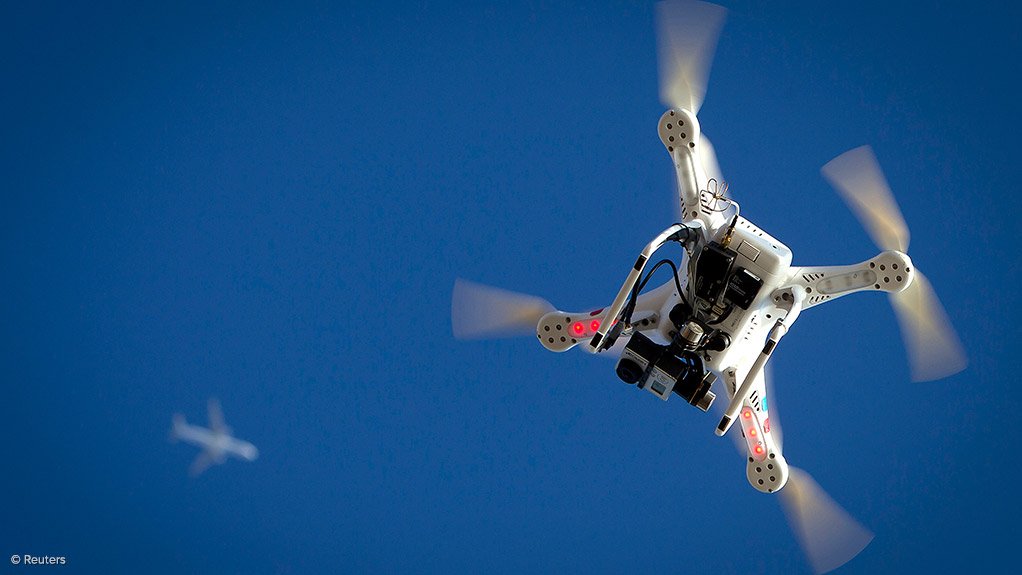The South African Civil Aviation Authority (SACAA) announced on Sunday that it was to introduce regulations for the operation of civilian remotely piloted aircraft systems (RPAS, previously known as unmanned air vehicles, or UAVs, and popularly called drones). Director of civil aviation Poppy Khoza described the announcement as “a momentous occasion in the history of the local aviation industry and to some extent the world”.
RPAS can be autonomous, or remotely-controlled, or use a combination of such systems. Widely used in military operations, they are being increasingly used in civilian applications as well. These civilian roles include aerial surveillance, nature conservation, scientific research and even journalism. These activities can be both commercial and noncommercial.
Khoza noted that “their rapid advancement [in civil aviation] has caught many regulators worldwide by some level of surprise. ... I am pleased to say that the SACAA together with the Department of Transport and other key industry role-players rose to the occasion and collectively worked tirelessly to develop these new regulations.” The new regulations will become effective on July 1.
The RPAS regulations form Part 101 of the country’s civil aviation regulations and do not apply to toy aircraft, unmanned free balloons, autonomous unmanned aircraft and other aircraft types that cannot be “managed on a real-time basis during flight”.
Under the new regulations, no remotely piloted aircraft (RPA) can be operated without a letter of approval (valid for 12 months) and no RPA can be sold unless the buyer is informed by the seller of the requirements of the SACAA. An RPA can only be flown if it is fit to fly, its control station is compatible and interoperable with the aircraft and is connected to it in all stages of the flight, if the RPA is controlled by “only one piloted aircraft station at any given moment in time” and if the RPA pilot holds a valid remote pilot licence.
RPAs are forbidden to tow other aircraft, undertake aerial or aerobatic displays, fly in formation or swarms, fly “adjacent to” or over crime scenes, law courts, nuclear power plants, police stations, prisons, national key points or strategic installations. Nor can they be flown at altitudes of more than 400 feet above ground level or within a 10 km radius of an aerodrome.
RPAs are also forbidden to fly within 50 m (laterally) of any person or group of people or directly over them. Nor may they be flown within 50 m (laterally) of any building or structure. They may also not be operated in weather conditions in which the RPA operator is unable to maintain uninterrupted visual contact with the aircraft, except when engaged in approved beyond line-of-sight or nocturnal operations. Public roads may not be used for the landing and taking off of RPAs, except if employed in civil defence or law enforcement operations (and, even so, “reasonable care” must be taken to safeguard people and property).
Before each flight, the remote pilot must complete a pre-flight inspection of the RPA. Other than when engaged in “restricted visual line of sight” flights, the RPA pilot must have a working airband radio, tuned to the frequency of the air traffic control unit managing the airspace within which the RPA is flying. “The RPA pilot shall, using the registration of the RPA as a call sign, make the required radio calls, indicating the altitude, location and intended operation of the RPA in that area and at such intervals as are required in order to ensure adequate separation from other aircraft is maintained,” observed Khoza.
No object may be released, dropped, dispensed, deployed or delivered from an RPA. No dangerous goods can be carried as cargo.
Except while under training, no one may pilot an RPA unless in possession of a valid remote pilot’s licence. There are three categories: aeroplane remote pilot licence, helicopter remote pilot licence and multirotor remote pilot licence. Three ratings may be endorsed on a remote pilot’s licence. These are – visual line of sight operations, extended visual line of sight operations and beyond visual line of sight operations. Applicants for a remote pilot’s licence must be at least 18 years old; have a valid Class 4 medical certificate for operations beyond visual line of sight or for operating Class 3 or higher RPAs; or have a restricted proficiency certificate in radiotelephony (aeronautical); and be able to prove proficiency in English at Level 4 or higher.
An RPA pilot must maintain a logbook containing a record of flight time, instrument time, simulation time and instruction time. All accidents and incidents involving RPAs must be reported, especially when people are injured, property damaged or the RPA is wrecked. An RPA must give way to manned aircraft and, in fact, avoid passing in front of, over or under a manned aircraft, unless it is well clear. RPA pilots must also take into account wake turbulence from manned aircraft.
“We are mindful that any form of regulation would never satisfy each and all stakeholders,” noted Khoza. “Let us be reminded that this is the very first attempt at regulating this new industry. Moreover, there are no best practices to benchmark against anywhere in the world. ... As the SACAA we are not claiming that these new regulations are static. ... hence we will continue to engage with industry to refine the regulations when, where and as deemed necessary.”
EMAIL THIS ARTICLE SAVE THIS ARTICLE
To subscribe email subscriptions@creamermedia.co.za or click here
To advertise email advertising@creamermedia.co.za or click here











